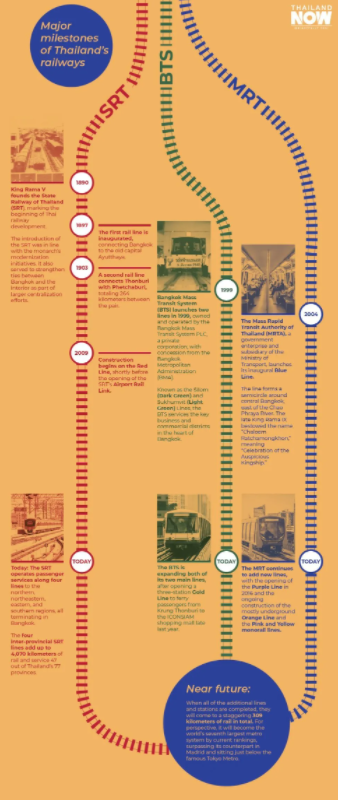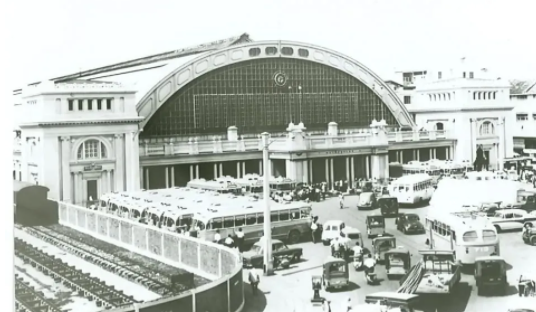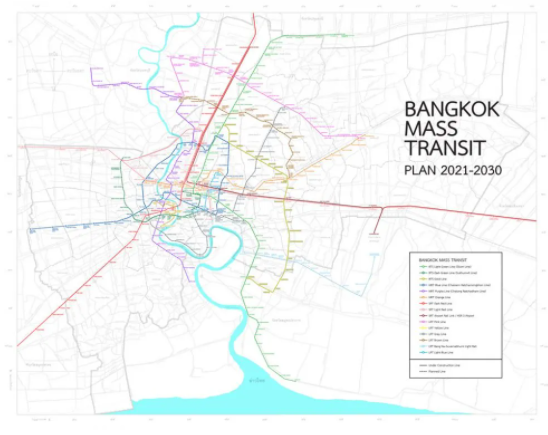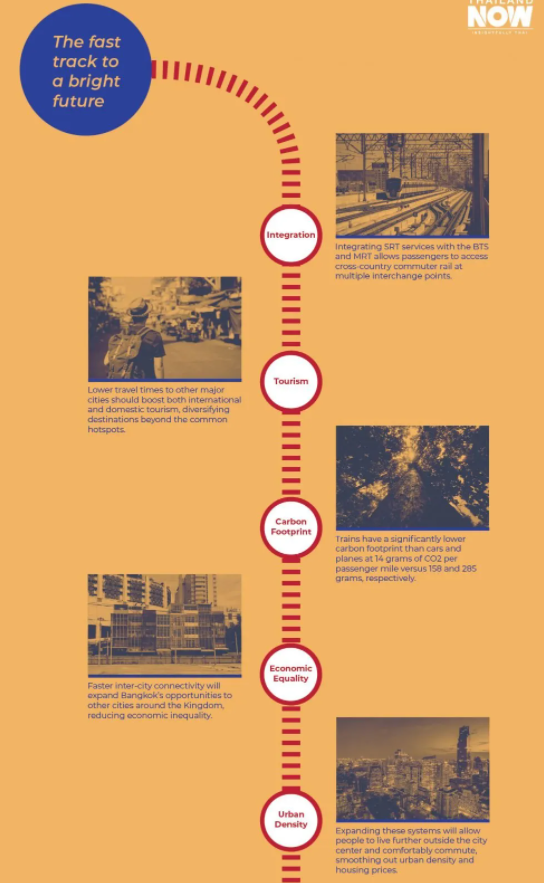New Red Line Forms Backbone of Thai Railways
New Red Line Forms Backbone of Thai Railways
วันที่นำเข้าข้อมูล 19 ม.ค. 2565
วันที่ปรับปรุงข้อมูล 29 พ.ย. 2565
The opening of new train routes is, thankfully, no longer a novel experience for the residents of Bangkok. The rapid expansion of the city’s metro system has seen the steady opening of new lines and routes on an almost yearly basis since 2016, slowly but surely weaving a delicate web from the dense urban center to its ever-growing outskirts.
The new SRT Red Line, which services Greater Bangkok’s northern outpost of Rangsit in Pathum Thani, and forays into the west with a stop in Taling Chan, looks no more significant at first glance than any of the other threads spinning out of the metropolis.
However, its 12 stations and 41 kilometers of rail lay at the crossroads of two of the most ambitious infrastructure projects in Thailand’s history; projects that will have major ramifications for the country’s social and economic development for years to come.
Thai railway development leaves the station
Understanding the different companies and enterprises at play in Bangkok’s sprawling metro system and Thailand’s wider train service is as difficult, if not more so, than navigating it. The haze of names, colors and acronyms can be overwhelming even to locals who rely on the system daily.

The Red Line emerges

Hua Lamphong station, the central train station in Bangkok, Thailand,
opened on June 25th, 1916. Source: SRT Facebook Page
Since its founding by King Rama Chulalongkorn in 1890, The State Railway of Thailand (SRT) has been responsible for national railway development and management. Still, with both the BTS and MRT metro lines in Bangkok, you might expect that rail lines in the capital lie outside the purview of the SRT.
However, the new Red Lines are actually their second foray into the capital’s complex transport web, their first being the Airport Rail Link (ARL) from Phaya Thai to Suvarnabhumi Airport built in 2010. The SRT’s handiwork can be also witnessed in places like Hua Lamphong, where their fleet of primarily diesel trains carry passengers to cities across the kingdom.
Much has changed over the last decade, and shifting your gaze from the beaten tracks stretching out from the old hub of Hua Lamphong to the grandeur of the newly constructed Bang Sue Grand Station feels like nothing short of time travel. The SRT has undergone significant plans to modernize cross-country transport, and this has led to the integration of the nation’s two most ambitious infrastructure projects.

The new SRT Red Line is actually made up of two separate routes—the Dark Red Line (running north to Pathum Thani)
and the Light Red Line (running west to Taling Chan). Source: FIFTYONE by Athi / Shutterstock.com
The Red Line’s inauguration comes at a time of rapid expansion for Bangkok’s metro system, such as the new Yellow, Pink, and Orange Lines being built by the MRT, as well as extensions to existing routes. The Red Line not only seamlessly slots into these expansions, but could well become their backbone once it is fully operational.
With far larger distances between stations and an average speed more than three times that of the BTS and MRT lines, the Red Line will become a crucial artery for Bangkok and massively expand its commutable zone. It dominates the image of a new metro map, forming a cross through the middle and providing convenient connections to the rest of the system.
While its presence and routes make it an invaluable part of the Bangkok metro system, the Red Line’s infrastructure will also service the SRT and their plans to radically overhaul cross-country travel and bring the nation closer together, at least in terms of commuting time.

The Red Line terminates at Bang Sue Station. Upon completion, it will be the largest railway station in
Southeast Asia and serve as a hub for every SRT railway line.
As mentioned previously, the Red Line terminates at the Bang Sue Grand Station and uses the new tracks built in tandem for that project. The cross-country trains which are currently “at-grade” (train speak for “on the ground”) will run along the same overpasses as the SRT Red Line, using adjacent tracks, which will be a first for Thailand.
Furthermore, it uses the same electrification system of overhead lines pioneered by the Red Line and Airport Rail Link, which will power the SRT’s new fleet once its diesel trains are eventually phased out. These advancements will culminate in the development of high-speed rail on selected lines, which are allegedly capable of making the 260-kilometer journey from Bangkok to Nakhon Ratchasima in just 77 minutes.
A prelude to radical improvements

The Red Line stands at the crossroads of two of the most ambitious infrastructure projects in Thailand’s history in terms of size and scale. Firstly, Bangkok’s “metro master plan” is a series of expansions which will bring the capital’s rail network on par with world-class urban centers. Meanwhile, the SRTs modernization plans will radically overhaul transport throughout the Kingdom, bringing cities and people closer than they have ever been before.
By linking these two projects, the SRT Red Line heralds an unprecedented integration between Bangkok’s urban rail and the nation-wide transportation system. Allowing trains from across the nation to connect with or even run through the mass transit system was first pioneered by the Tokyo Metro, where it has been a resounding success, and is also the thinking behind London’s multi-billion pound Crossrail project.
The new Red Line is also a prelude to developments which promise a major improvement in connectivity, the expansion of economic opportunities, and more sustainable modes of transport to carry Thailand into the future.

Thailand has much to gain from the development of the new Red Line and Bangkok’s metro expansion.
Bangkok’s metro expansion is considered to be a vital and necessary step in the city’s development. The greater metropolitan region’s population has climbed to 15 million people, stretching the current road and highway system to capacity; a quick and convenient alternative is necessary to reduce pressure on Bangkok’s streets and highways. These connectivity can also help to smooth out urban density within the city, and similarly expand access and economic opportunity across the country.
For Bangkok’s commuters, the SRT Red Line may not appear as anything more than another dash on the city’s expanding transport map as of today. However, by bringing together two of the nation’s most ambitious infrastructure projects, it represents the start of a radical overhaul of Thailand’s transportation system, and its effects will be felt in the years and decades to come.

Royal Thai Consulate-General, Guangzhou